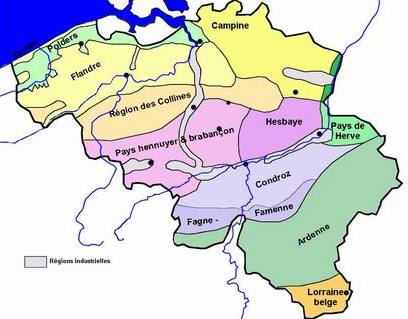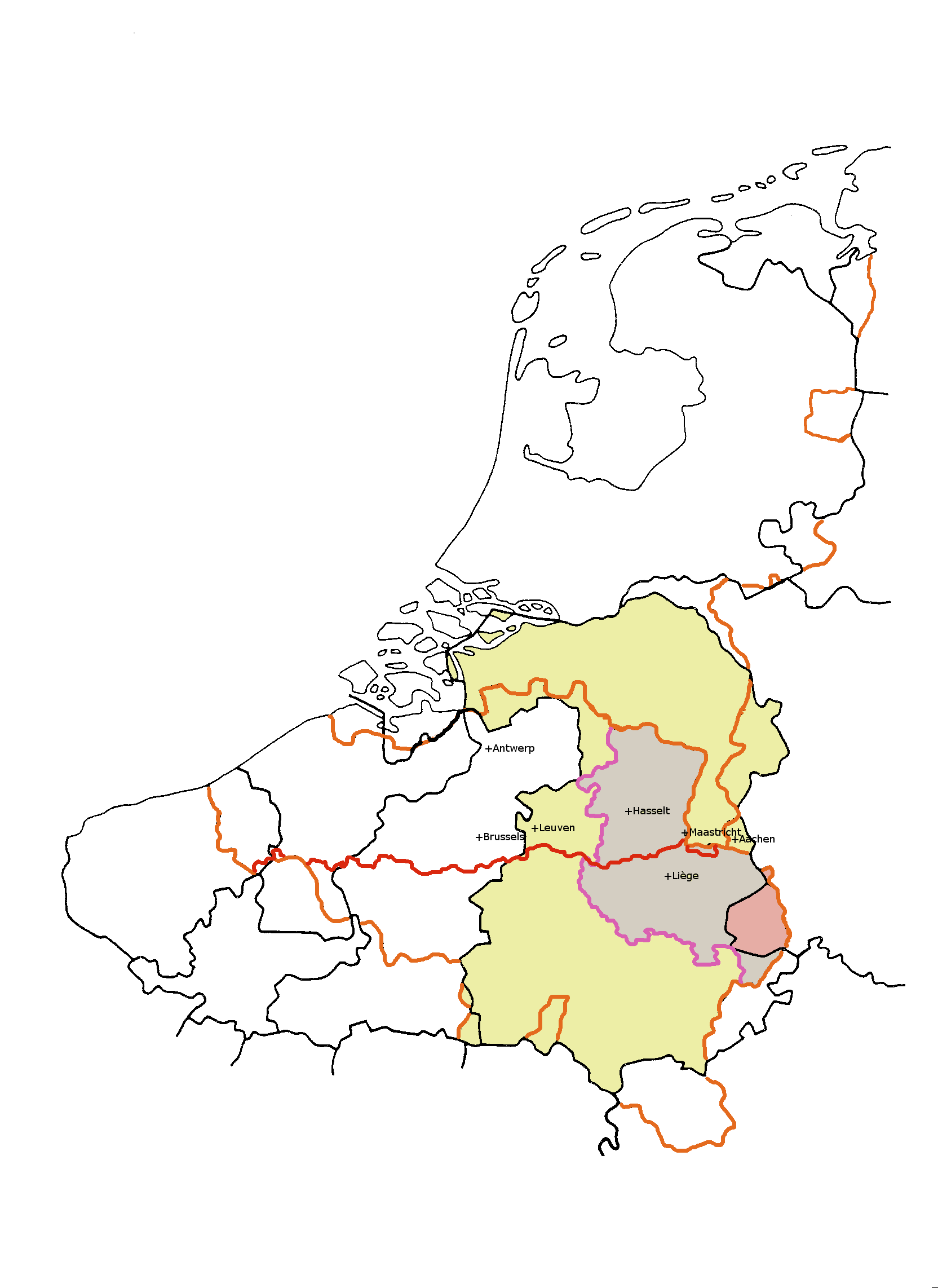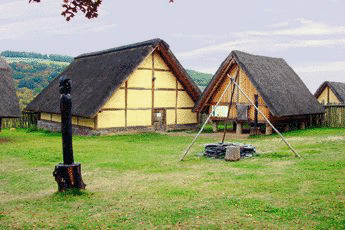|
Condrusi
The Condrusi were an ancient Belgic- Germanic tribe dwelling in what is now eastern Belgium during the Gallic Wars (58–50 BC) and the Roman period. Their ethnic identity remains uncertain. Caesar described them as part of the Germani Cisrhenani, but their tribal name is probably of Celtic origin. Like other Germani Cisrhenani tribes, it is possible that their old Germanic endonym came to be abandoned after a tribal reorganization, that they received their names from their Celtic neighbours, or else that they were fully or partially assimilated into Celtic culture at the time of the Roman invasion of the region in 57 BC. Name They are mentioned as ''Condrusos'' and ''Condrusi'' by Caesar (mid-1st c. BC), and as ''Condurses'' by Orosius (early 5th c. AD)., entry 1967. The meaning of the name ''Condrusi'' remains unclear. The prefix is most likely the Gaulish ''con-/com-'' ('with, together, as well'), and although the translation of the element ''-drus-'' is unknown, it is also ... [...More Info...] [...Related Items...] OR: [Wikipedia] [Google] [Baidu] |
Eburones
The Eburones ( Greek: ) were a Gallic- Germanic tribe dwelling in the northeast of Gaul, in what is now the southern Netherlands, eastern Belgium and the German Rhineland, in the period immediately preceding the Roman conquest of the region. Though living in Gaul, they were also described as being both Belgae and Germani (for a discussion of these terms, see below). The Eburones played a major role in Julius Caesar's account of his "Gallic Wars", as the most important tribe within the '' Germani cisrhenani'' group of tribes — ''Germani'' living west of the Rhine amongst the Belgae. Caesar claimed that the name of the Eburones was wiped out after their failed revolt against his forces during the Gallic Wars, and that the tribe was largely annihilated. Whether any significant part of the population lived on in the area as Tungri, the tribal name found here later, is uncertain but considered likely. Name Attestations They are mentioned as ''Eburones'' by Caesar (mid-1st ... [...More Info...] [...Related Items...] OR: [Wikipedia] [Google] [Baidu] |
Condroz
The Condroz () is a natural region in Wallonia (the French-speaking part of Belgium), located to the north-west of the Ardennes. Its unofficial capital is Ciney. The region preserves the name of the Condrusi, a Germanic tribe which inhabited the area in the Roman era. Compared to other parts of Belgium, the Condroz is a sparsely populated, agricultural area. It consists of low hills of an average altitude of about 200 to 300 meters (670–970 feet). It is mainly situated in the provinces of Liège and Namur and also in smaller parts of the Belgian provinces of Hainaut and Luxembourg. It is bordered in the north by the Meuse river, in the east by the Ardennes, in the south by the Famenne region. Historically, the Condroz did not stretch west of the Meuse, but today there is a western section, south of Namur and the Sambre river stretching to the Thiérache and southern Hainaut. History Very little is known of the Roman era Condrusi, after whom the region was originally na ... [...More Info...] [...Related Items...] OR: [Wikipedia] [Google] [Baidu] |
Germani Cisrhenani
The ''Germani cisrhenani'' (Latin '' cis- rhenanus'' "on this side of the Rhine", referring to the Roman or western side), or "Left bank ''Germani''", were a group of Germanic peoples who lived west of the Lower Rhine at the time of the Gallic Wars in the mid-1st century BC. These ''Germani'' were first described by Julius Caesar, who was writing specifically about tribes near the Meuse river, who had settled among the Belgae before Roman intrusion into the area. Tribes who Caesar named as being among the ''Germani cisrhenani'' included the Eburones, the Condrusi, the Caeraesi, the Segni and the Paemani. Tacitus, writing around 100 AD when the region had been part of the Roman Empire, referred to these ''Germani'' next, saying that they were by his time called the Tungri. The "''Germani''" name had by this time become a term used more commonly to refer to many other peoples. Name and terminology Starting with Caesar, Roman historians described the Rhine as an important natu ... [...More Info...] [...Related Items...] OR: [Wikipedia] [Google] [Baidu] |
Civitas Tungrorum
The ''Civitas Tungrorum'' was a large Roman administrative district dominating what is now eastern Belgium and the southern Netherlands. In the early days of the Roman Empire it was in the province of Gallia Belgica, but it later joined the neighbouring lower Rhine River border districts, within the province of Germania Inferior. Its capital was ''Aduatuca Tungrorum'', now Tongeren. Like many other Roman administrative districts, it was named after the tribal grouping that lived there, the Tungri, although that name is not known from the area before it became part of the Roman Empire. Also like other such districts, it became the basis for a medieval bishopric, but the bishops of Tongeren moved first to nearby Maastricht and then to Liège. Location The geographical boundaries of the ''civitas'' probably corresponded at least roughly to the area of the large medieval Catholic diocese of Liège, which was reduced in 1559. In modern terms this large diocese contained approximately th ... [...More Info...] [...Related Items...] OR: [Wikipedia] [Google] [Baidu] |
Segni (tribe)
The Segni were an ancient tribe dwelling in the Ardennes and Eifel region during the Iron Age. In the winter of 54–53 BC, the Segni assured Julius Caesar, by means of an embassy, that they would not make common cause with the other Germani Cisrhenani (the Germani on the left bank of the river Rhine). Name The etymology of the ethnonym ''Segni'' remains unclear. It may derive from the Celtic stem ''*sego-'' ('victory, force') or from the root ''*seg-'' ('sowing'), or else be related to the Old Irish ''sén'' ('net'). However, an alternative Germanic origin is also possible since the Germanic ''-ng-'' consonantal cluster was often transcribed to ''-gn-'' in Latin (e.g. ''Reudigni'', ''Marsigni''). An etymology from ''*sengjōz'' ('those who live in a dried region'; cf. MHG ''singe'' 'dryness, drought'), itself a derivative of ''*setig'' ('burning, drying'), has thus be posited by some scholars. Culture Their ethnic identity remains uncertain. The Segni were listed among the G ... [...More Info...] [...Related Items...] OR: [Wikipedia] [Google] [Baidu] |
Treveri
The Trēverī (Gaulish: *''Trēueroi'') were a Celtic tribe of the Belgae group who inhabited the lower valley of the Moselle from around 150 BCE, if not earlier, until their displacement by the Franks. Their domain lay within the southern fringes of the ''Silva Arduenna'' ( Ardennes Forest), a part of the vast Silva Carbonaria, in what are now Luxembourg, southeastern Belgium and western Germany; its centre was the city of Trier (''Augusta Treverorum''), to which the Treveri give their name. Celtic in language, according to Tacitus they claimed Germanic descent. Tacitus writes, "The Treveri and Nervii are even eager in their claims of a German origin, thinking that the glory of this descent distinguishes them from the uniform level of Gallic effeminacy." '' Germania'' XXVIII. They possibly contained both Gallic and Germanic influences. Although early adopters of Roman material culture, the Treveri had a chequered relationship with Roman power. Their leader Indutiomarus le ... [...More Info...] [...Related Items...] OR: [Wikipedia] [Google] [Baidu] |
Belgae
The Belgae () were a large confederation of tribes living in northern Gaul, between the English Channel, the west bank of the Rhine, and the northern bank of the river Seine, from at least the third century BC. They were discussed in depth by Julius Caesar in his account of his wars in Gaul. Some peoples in Britain were also called Belgae, and O'Rahilly equated them with the Fir Bolg in Ireland. The Belgae gave their name to the Roman province of Gallia Belgica and, much later, to the modern country of Belgium; today "Belgae" is also Latin for "Belgians". Etymology The consensus among linguists is that the ethnic name ''Belgae'' comes from the Proto-Celtic root ''*belg-'' or ''*bolg-'' meaning "to swell (particularly with anger/battle fury/etc.)", cognate with the Dutch adjective ''gebelgd'' "very angry" (weak perfect participle of the verb ''belgen'' "to become angry") and ''verbolgen'' "being angry" (strong perfect participle of obsolete ''verbelgen'' "to make angry"), as w ... [...More Info...] [...Related Items...] OR: [Wikipedia] [Google] [Baidu] |
Meuse
The Meuse ( , , , ; wa, Moûze ) or Maas ( , ; li, Maos or ) is a major European river, rising in France and flowing through Belgium and the Netherlands before draining into the North Sea from the Rhine–Meuse–Scheldt delta. It has a total length of . History From 1301 the upper Meuse roughly marked the western border of the Holy Roman Empire with the Kingdom of France, after Count Henry III of Bar had to receive the western part of the County of Bar (''Barrois mouvant'') as a French fief from the hands of King Philip IV. In 1408, a Burgundian army led by John the Fearless went to the aid of John III against the citizens of Liège, who were in open revolt. After the battle which saw the men from Liège defeated, John ordered the drowning in the Meuse of suspicious burghers and noblemen in Liège. The border remained stable until the annexation of the Three Bishoprics Metz, Toul and Verdun by King Henry II in 1552 and the occupation of the Duchy of Lorraine ... [...More Info...] [...Related Items...] OR: [Wikipedia] [Google] [Baidu] |
Liège
Liège ( , , ; wa, Lîdje ; nl, Luik ; german: Lüttich ) is a major city and municipality of Wallonia and the capital of the Belgian province of Liège. The city is situated in the valley of the Meuse, in the east of Belgium, not far from borders with the Netherlands ( Maastricht is about to the north) and with Germany ( Aachen is about north-east). In Liège, the Meuse meets the river Ourthe. The city is part of the '' sillon industriel'', the former industrial backbone of Wallonia. It still is the principal economic and cultural centre of the region. The municipality consists of the following districts: Angleur, , Chênée, , Grivegnée, Jupille-sur-Meuse, Liège, Rocourt, and Wandre. In November 2012, Liège had 198,280 inhabitants. The metropolitan area, including the outer commuter zone, covers an area of 1,879 km2 (725 sq mi) and had a total population of 749,110 on 1 January 2008. [...More Info...] [...Related Items...] OR: [Wikipedia] [Google] [Baidu] |
Namur (city)
Namur (; ; nl, Namen ; wa, Nameur) is a city and municipality in Wallonia, Belgium. It is both the capital of the province of Namur and of Wallonia, hosting the Parliament of Wallonia, the Government of Wallonia and its administration. Namur stands at the confluence of the rivers Sambre and Meuse The Meuse ( , , , ; wa, Moûze ) or Maas ( , ; li, Maos or ) is a major European river, rising in France and flowing through Belgium and the Netherlands before draining into the North Sea from the Rhine–Meuse–Scheldt delta. It has a ... and straddles three different regions – Hesbaye to the north, Condroz to the south-east, and Entre-Sambre-et-Meuse to the south-west. The city of Charleroi is located to the west. The language spoken is French language, French. The municipality consists of the following Deelgemeente#Belgium, districts: Beez, Namur, Beez, Belgrade, Namur, Belgrade, Boninne, Bouge, Champion, Namur, Champion, Cognelée, Daussoulx, Dave (Belgium ... [...More Info...] [...Related Items...] OR: [Wikipedia] [Google] [Baidu] |
Régions Naturelles De Belgique
France is divided into eighteen administrative regions (french: régions, singular ), of which thirteen are located in metropolitan France (in Europe), while the other five are overseas regions (not to be confused with the overseas collectivities, which have a semi-autonomous status). All of the thirteen metropolitan administrative regions (including Corsica ) are further subdivided into two to thirteen administrative departments, with the prefect of each region's administrative centre's department also acting as the regional prefect. The overseas regions administratively consist of only one department each and hence also have the status of overseas departments. Most administrative regions also have the status of regional territorial collectivities, which comes with a local government, with departmental and communal collectivities below the region level. The exceptions are Corsica, French Guiana, Mayotte and Martinique, where region and department functions are manag ... [...More Info...] [...Related Items...] OR: [Wikipedia] [Google] [Baidu] |
Ardennes
The Ardennes (french: Ardenne ; nl, Ardennen ; german: Ardennen; wa, Årdene ; lb, Ardennen ), also known as the Ardennes Forest or Forest of Ardennes, is a region of extensive forests, rough terrain, rolling hills and ridges primarily in Belgium and Luxembourg, extending into Germany and France. Geologically, the range is a western extension of the Eifel; both were raised during the Givetian age of the Devonian (382.7 to 387.7 million years ago), as were several other named ranges of the same greater range. The Ardennes proper stretches well into Germany and France (lending its name to the Ardennes department and the former Champagne-Ardenne region) and geologically into the Eifel (the eastern extension of the Ardennes Forest into Bitburg-Prüm, Germany); most of it is in the southeast of Wallonia, the southern and more rural part of Belgium (away from the coastal plain but encompassing more than half of the country's total area). The eastern part of the Ardennes forms t ... [...More Info...] [...Related Items...] OR: [Wikipedia] [Google] [Baidu] |





.jpg)


